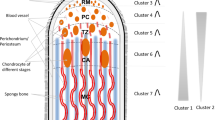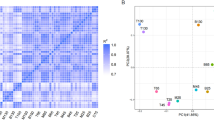Abstract
Backgroud
Reindeer is the only deer species that both male and female produce antlers, which provides a particularly interesting case in studying the differences between antlers of the two sexes. Alpha 3(VI) Collagen Gene (COL6A3), forms a microfibrillar network associated with the structural integrity and biomechanical properties, has been found to be one of the differentially expressed genes in antler mesenchyme of female and male reindeer.
Objective and Methods
The promoter sequence of reindeer COL6A3 gene was obtained using the cloning technology and analyzed by the bioinformatics methods. Bisulfite sequencing PCR (BSP) was used to detect the methylation status of the COL6A3 promoter in reindeer antler mesenchyme. Real-time quantitative PCR was used to detect COL6A3 expression in the antler mesenchyme of female and male reindeer.
Results
Sequence analysis revealed that the reindeer COL6A3 partial promoter sequence was 983 bp including the possible promoter region at + 105 bp to + 155 bp. Homology and phylogenetic analysis indicated that the COL6A3 promoter of reindeer had the closest genetic distance with Bos taurus, Capra hircus and Ovis aries. BSP results indicated that the methylation level of COL6A3 promoter in the female reindeer antler mesenchyme was significantly higher than in the male. Correlating with increased methylation status, we also found that COL6A3 mRNA expression in female reindeer antler mesenchyme was significantly lower than in the male.
Conclusion
The higher methylation level of the COL6A3 gene in female reindeer antler mesenchyme coincides with decreased COL6A3 mRNA expression, thereby affecting the transposon silencing mechanism and possibly contributing to apparent differences of antlers in female and male reindeer.




Similar content being viewed by others
References
Barling PM, Liu H, Matich J, Mount J, Lai KWA, Ma L, Nicholson LFB (2004) Expression of PTHrP and the PTH/PTHrP receptor in growing red deer antler. Cell Biol Int 28:661–673
Bubenik GA, Sempere AJ, Hamr J (1987) Developing antler, a model for endocrine regulation of bone growth. Concentration gradient of T3, T4, and alkaline phosphatase in the antler, jugular, and the saphenous veins. Calcif Tissue Int 41:38–43
Clark DE, Lord EA, Suttie JM (2006) Expression of VEGF and pleiotrophin in deer antler. Anat Rec Part A 288:1281–1293
Esteller M (2008) Epigenetics in cancer. N Engl J Med 358:1148
Fujita T, Ohue M, Fujii Y, Miyauchi A, Takagi Y (2002) The effect of active absorbable algal calcium (AAA Ca) with collagen and other matrix components on back and joint pain and skin impedance. J Bone Miner Metab 20:298–302
Gelfman S, Cohen N, Yearim A, Ast G (2013) DNA-methylation effect on cotranscriptional splicing is dependent on GC architecture of the exon–intron structure. Genome Res 23:789–799
Grunstein M (1997) Histone acetylation in chromatin structure and transcription. Nature 389:349–352
Herrscher RF, Kaplan MH, Lelsz DL, Das C, Scheuermann R, Tucker PW (1995) The immunoglobulin heavy-chain matrix-associating regions are bound by Bright: a B cell-specific trans-activator that describes a new DNA-binding protein family. Gene Dev 9:3067
Høymork A, Reimers E (2002) Antler development in reindeer in relation to age and sex. Rangifer 22:75–82
Jeltsch A (2002) Beyond Watson and Crick: DNA methylation and molecular enzymology of DNA methyltransferases. ChemBioChem 3:275–293
Kapanen A, Ryhänen J, Birr E, Väänänen HK, Tuukkanen J (2002) Bone morphogenetic protein 3b expressing reindeer antler. J Biomed Mater Res 59:78
Kierdorf U, Kierdorf H (2011) Deer antlers—a model of mammalian appendage regeneration: an extensive review. Gerontology 57:53–65
Kivirikko KI (1993) Collagens and their abnormalities in a wide spectrum of diseases. Ann Med 25:113–126
Klose RJ, Bird AP (2006) Genomic DNA methylation: the mark and its mediators. Trends Biochem Sci 31:89–97
Kumaki Y, Oda M, Okano M (2008) QUMA: quantification tool for methylation analysis. Nucl Acids Res 36:170–175
Li C (2013) Histogenetic aspects of deer antler development. Front Biosci 5:479
Li C, Suttie JM (2003) Tissue collection methods for antler research. Eur J Morphol 41:23–30
Li C, Clark DE, Lord EA, Stanton JA, Suttie JM (2002) Sampling technique to discriminate the different tissue layers of growing antler tips for gene discovery. Anat Rec 268:125
Li C, Stanton JA, Robertson TM, Suttie JM, Sheard PW, Harris AJ, Clark DE (2007) Nerve growth factor mRNA expression in the regenerating antler tip of red deer (Cervus elaphus). PLoS ONE 2:e148
Liu M, Yao B, Zhang H, Guo H, Hu D, Wang Q, Zhao Y (2014) Identification of novel reference genes using sika deer antler transcriptome expression data and their validation for quantitative gene expression analysis. Genes Genom 36:573–582
Mayer U, Pöschl E, Nischt R, Specks U, Pan TC, Chu ML, Timpl R (1994) Recombinant expression and properties of the Kunitz-type protease-inhibitor module from human type VI collagen alpha 3(VI) chain. Eur J Biochem 225:573–580
Momparler RL, Bovenzi V (2000) DNA methylation and cancer. J Cell Physiol 183:145
Moskowitz R (2000) Role of collagen hydrolysate in bone and joint disease. Semin Arthritis R 30:87–99
Pan TC et al (2013) COL6A3 protein deficiency in mice leads to muscle and tendon defects similar to human collagen VI congenital muscular dystrophy. J Biol Chem 288:14320–14331
Price J, Allen S (2004) Exploring the mechanisms regulating regeneration of deer antlers. Philos Trans R Soc B 359:809–822
Price J, Faucheux C, Allen S (2005) Deer antlers as a model of Mammalian regeneration. Curr Top Dev Biol 67:1–48
Specks U et al (1992) Structure of recombinant N-terminal globule of type VI collagen alpha 3 chain and its binding to heparin and hyaluronan. EMBO J 11:4281–4290
Stadler MB et al (2011) DNA-binding factors shape the mouse methylome at distal regulatory regions. Nature 480:490–495
Szyf M (2005) DNA methylation and demethylation as targets for anticancer therapy. Biochemistry 70:533–549
Thummel R, Burket CT, Hyde DR (2015) Two different transgenes to study gene silencing and re-expression during zebrafish caudal fin and retinal regeneration. Sci World J 6:65–81
Wang R, Xu J (2014) Genomic DNA methylation and histone methylation. Hereditas 36:191
Yang C, Lu X, Sun H, Chu WH, Li C (2016) Analysis of genomewide DNA methylation reveals differences in DNA methylation levels between dormant and naturally as well as artificially potentiated pedicle periosteum of sika deer (Cervus nippon). J Exp Zool Part B 326:375–383
Yao B, Yu Z, Wang Q, Mei Z, Liu M, Liu H, Li J (2012) De novo characterization of the antler tip of Chinese Sika deer transcriptome and analysis of gene expression related to rapid growth. Mol Cell Biochem 364:93–100
Zhai J, Gao L, Xia Y, Li H (2017) A study on differentially expressed genes in reserve mesenchyme of male and female reindeer antler tip. Pak J Zool 49:889–895
Acknowledgements
This study was financially supported by the Fundamental Research Funds for the Central Universities (2572016AA42), and the Project for Field Rescue and Captive Breeding of Endangered Species of the State Forestry Administration of China (2012).
Author information
Authors and Affiliations
Corresponding author
Ethics declarations
Conflict of interest
We certify that there is no conflict of interest with any financial organization regarding the material discussed in the manuscript.
Additional information
Publisher's Note
Springer Nature remains neutral with regard to jurisdictional claims in published maps and institutional affiliations.
Rights and permissions
About this article
Cite this article
Zhai, JC., Han, RB., Wang, SN. et al. DNA methylation and mRNA expression of COL6A3 in antler mesenchyme of female and male reindeer. Genes Genom 41, 1007–1013 (2019). https://doi.org/10.1007/s13258-019-00829-3
Received:
Accepted:
Published:
Issue Date:
DOI: https://doi.org/10.1007/s13258-019-00829-3




